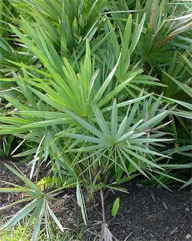Introduction to Saw Palmetto (Serenoa Repens)

COMMON NAME
Saw Palmetto, Sabal
LATIN NAME
Serenoa serrulata, Serenoa repens, Sabal serulata
ORIGIN
North American Atlantic Coast
PART OF PLANT USED
Berries
ACTIVE SUBSTANCES
steroidal saponins, fatty acids, phytosterols, volatile oil, resin, tannins
STANDARD
90% free fatty acids
DESCRIPTION
Saw Palmetto is a small palm tree with large leaves and large deep red-blackberries. The berries were used by the American Indians as a general tonic to nourish the body and encourage appetite and normal weight gain. The berries were also used in the treatment of genito-urinary tract problems including enuresis, nocturia, and urinary tract disorders. Recent clinical trials have shown that saw palmetto berries are helpful in the treatment of benign prostatic hyperplasia.
PHARMACOLOGY
Saw Palmetto berries contain an oil with a variety of fatty acids and phytosterols. These fatty acids include capric, caprylic, caproic, lauric, palmitic, and oleic acid and their ethyl esters. The major phytosterols are beta-sitosterol, stig masterol, cycloartenol, stigmas terol, cycloartenol, lupeol, lupenone, and 24-methyl-cycloartenol. The fat soluble extract of saw palmetto berries has been shown to inhibit the conversion of testosterone (DHT) which is thought to be responsible for the enlargement of the prostate. In addition saw palmetto extract inhibits the binding of DHT to receptors thus blocking DHT's action and promoting the breakdown of the potent compound.
ACTIVE PROPERTIES
The North American Indians used saw palmetto berries as a remedy for atrophy of the testes, impotence, inflammation of the prostate, and low libido in men. The berries are also recommended for infertility, painful periods, and lactation in women. The berries also have a traditional use as a tonic and expectorant for mucous membranes, particularly the bronchial passages.
HISTORICAL USES
- Urinary tract disorders, nocturia, enuresis
- Benign Prostatic Hypertrophy, prostate inflammation
- Impotence, low libido
- Atrophy of the testes
- Infertility in women
- Increase lactation
- Painful periods, tonic for ovarian function
- Expectorant, inhalant, bronchitis, asthma, catarrh, colds
- General nutritional tonic to increase fat, muscle, strength
- Tonic for mucous membranes
- Mildly sedative to the nervous system
- Anti-inflammatory
- Appetite stimulant, improve digestion
- Thyroid deficiency
DIRECTIONS FOR USE
320 mg / day
BIO-ENHANCING AGENTS
African Pygeum
TOXICITY, CAUTIONS & CONTRA-INDICATIONS
No reported toxicity.
PROCESSING
Purified fat soluble extract.
SCIENTIFIC REFERENCES
- Campault, G. et al. (1984) A double blind trial of an extract of the plant Seronoa repens in benign prostatic hyperplasia. Br. J. Clin Pharm. 18:461.
- Mowrey, D. ( 1986) The Scientific Validation of Herbal Medicine. Cormorant Books.
ANALYSIS
| Product | Saw Palmetto |
| Type/td> | Standardized extract |
| Standardization | 90% free fatty acids |
| Character | yellow color |
| Solubility | soluble in hexane |
| Loss on drying | 5.5% |
| Assay: Main free fatty acids | |
| Caprylic acid | 7% |
| Capric acid | 6% |
| Lauric acid | 19.3% |
| Myristic acid | 12.4% |
| Palmitic acid | 8.1% |
| Palmitoleic acid | 3% |
| Stearic acid | 1.9% |
| Oleic acid | 41.2% |
| Linoleic acid | 2.3% |
| Linolenic acid | 0.9% |
| Arachidic acid | 0.04% |
| Main esters of: | |
| Caprylic acid | 12% |
| Capric acid | 4% |
| Lauric acid | 2.3% |
| Myristic acid | 0.6% |
| Palmitic acid | 0.4% |
| Oleic acid | 1.7% |
| Linoleic acid | 0.6% |
| Acid value | 148.6 |
| Saponification value | 222.2 |
| Iodine value | 42.5 |
| Unsaponifiable value | 1.7% |
| Sterols | 1.4% |
| Microbiological Specifications | |
| Gram negatives | absent |
| E. coli | absent |
| Staph. aureus | absent |
| Pseudomonas aeruginosa | absent |
| Salmonell sp. | absent |